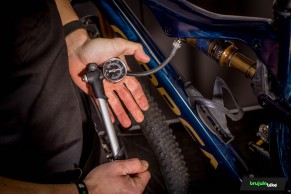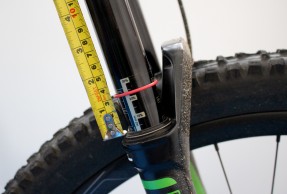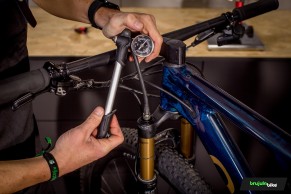How to adjust your MTB suspensions to your weight?
We explain what you need to adjust your suspension and how to do it in 8 simple steps. Take note because it is a simple procedure if you know how to do it without damaging your suspension or riding uncomfortably.
What you need to adjust the suspension
You only need two tools to adjust the suspension and one of them is in any house: a meter or a tape measure. The other tool you need is much more specific: it is a suspension pump, a tool to adjust the suspension that is quite similar to a normal and ordinary air pump for wheels, but with a different nozzle and a nanometer regulated differently, although it looks aesthetically similar.
The suspension pump will serve you to insert the appropriate pressure to your bike, your weight and the terrain you frequent; the meter will be used to measure the travel and adjust it perfectly.

RECOMENDADO

Complete list of the highest paid cyclists of 2025

How many calories are burned when cycling

What is heart rate variability and how does it affect the cyclist?

Change wheels if you want to transform your bike's behavior

What bike size do you need? Here's how to find out

How does age affect performance and recovery?
Unless you mount a strange thing, your suspension will be standard, and adjusting it will be simple.
How to adjust your suspension step by step
Remember a basic concept: the SAG. Adjusting your suspension is determined by the SAG. The SAG is also known as pre-sinking, and it is nothing more than the travel of the suspension when the weight of the bicycle and the cyclist is applied. Correctly adjusting the SAG is essential to, on the one hand absorb bumps, and on the other avoid damaging the suspension due to a bad adjustment.

We indicate how to adjust your suspension step by step:
1. Fully open the suspension, eliminating the pressure through the dials or knobs located for this purpose. Turn counterclockwise and let all the air escape to start from scratch. The distance between your air-free suspension and its most stretched position is the travel of your suspension.
2. On the internet you will find suspension calculators, in which indicating your weight and that of your bike you will know how to adjust your suspension correctly. Close the dials and insert the indicated pressure. But if you want to do the calculation by hand, take note: once you have the total travel of your suspension, calculate between 15% and 30% of it. For example, if your suspension has 100mm of travel, calculate 15 if you will travel on less demanding terrain, or 30 if you go through steep and broken areas and you are more of going off the beaten path.
3. Get dressed on the bike and insert the pressure until the suspension is placed at the indicated point. Insert the pressure indicated by the brand, neither more nor less, or in the position in which you have previously calculated.

4. Test the suspension. Beware, after adjusting the suspension you should test it fully dressed, with all the equipment you usually wear: shoes, clothes and helmet of course, plus backpack or accessories in case you carry them frequently.

5. Place the O-rings (a kind of rubber rings) on the edge of the suspension. Press down throwing all your weight on the suspension.
6. Get off carefully and measure the distance from the beginning of the suspension pump and the position where the rubber has remained after the suspension adjustment.
7. That distance is the SAG of your suspension. If, despite this, you feel it too soft or hard depending on the terrain you frequent, you can vary a millimeter, but no more for safety for the components.
8. Finally, test the adjustment of your suspension on the terrain, which is where you will really know if it is well regulated. You can make small periodic checks to check that your SAG and the response of your suspension continue at their optimal point.

If in doubt, always use the formula we propose and do not force because you can damage it trying to adjust your suspension. If you don't know how to do it, and you prefer a professional to do it, it is a simple process that in any specialized workshop they can do in just a few minutes. An optimal suspension adjustment will help you pedal better, avoid postures or rebounds that overload or injure your physique, and feel more secure on your bike, if not too much rebound impossible to lift, nor too much hardness that throws you into the air.